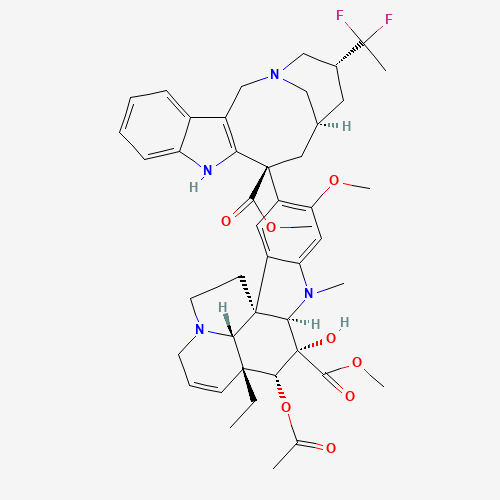| Pharmaceutical Information |
| Drug Name |
Vinflunine |
| Drug ID |
BADD_D02362 |
| Description |
Vinflunine is a third-generation member of the vinca alkaloid family with anti-tumour actions. It was first described in 1998 at the Pierre Fabre research center in France. Like other vinca agents, vinflunine is an anti-mitotic agent that induces a cell cycle arrest at the G2/M phase and promotes cell death via apoptosis [L1396]. Vinflunine is a microtubule inhibitor that binds to tubulin at or near to the vinca binding sites to inhibits its polymerization into microtubules during cell proliferation [L1396]. In murine tumors and human tumor xenografts, vinflunine exhibits an antitumor efficacy than [DB00361], [DB00570], and [DB00541] [A31975].
Having an incidence of 429,700 new cases per year worldwide, urothelial carcinoma of the bladder is one of the most common malignancies that mostly affects individuals aged 50–79 years [A32626]. Some patients with advanced urothelial carcinoma experience inadequate therapeutic response from a prior platinum-containing regimen. While these patients have a median survival of approximately 4 months and a poor prognosis [L1396], there is currently no standard therapy in patients with advanced urothelial carcinoma [A32626]. In 2009, vinflunine was approved by the European Medicines Agency (EMA) as a second-line therapy of metastatic and advanced urothelial cancer after failure of platinum-based treatment [A32626]. Vinflunine ditartrate is an active ingredient in the EMA-authorised product Javlor for intravenous infusion. Efficacy and safety of vinflunine has not been studied in patients with performance status of 2 or less. The clinical use of vinflunine in other urologic malignancies, such as inoperable cancer of the penis, are currently have been investigated [A32626]. |
| Indications and Usage |
For use as a monotherapy in adults with advanced or transitional cell carcinoma of the urothelial tract after failure of a prior platinum-containing therapy [L2381]. |
| Marketing Status |
approved; investigational |
| ATC Code |
L01CA05 |
| DrugBank ID |
DB11641
|
| KEGG ID |
D09032
|
| MeSH ID |
C111217
|
| PubChem ID |
10629256
|
| TTD Drug ID |
D0OT9S
|
| NDC Product Code |
Not Available |
| UNII |
5BF646324K
|
| Synonyms |
vinflunine | Javlor |
|
| Chemical Information |
| Molecular Formula |
C45H54F2N4O8 |
| CAS Registry Number |
162652-95-1 |
| SMILES |
CCC12C=CCN3C1C4(CC3)C(C(C2OC(=O)C)(C(=O)OC)O)N(C5=CC(=C(C=C45)C6(CC7CC(CN(C7)CC8
=C6NC9=CC=CC=C89)C(C)(F)F)C(=O)OC)OC)C |
| Chemical Structure |

|
|
| ADRs Induced by Drug |
|
|
*The priority for ADR severity classification is based on FAERS assessment, followed by the most severe level in CTCAE rating. If neither is available, it will be displayed as 'Not available'.
**The 'Not Available' level is hidden by default and can be restored by clicking on the legend twice.
|
|
|

